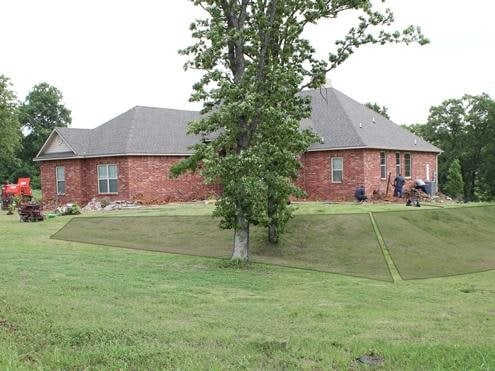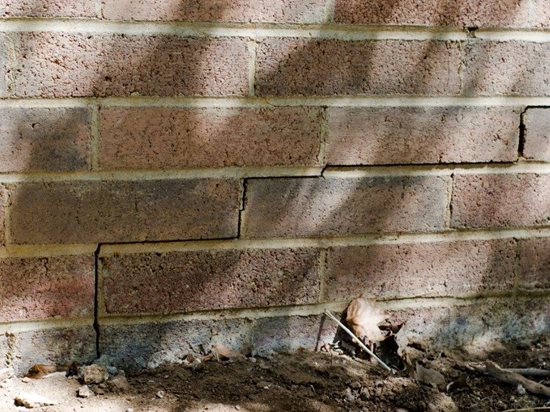- Foundation Repair Home
- Foundation Repair Cost: What are the variables?
- Does Insurance Cover Foundation Repair?
- Foundation Cracks
- Methods of Repair
- Piering: Fixing your home's issues
- Slabjacking: What is slabjacking?
- Related Information:
- Concrete repair: Repair methods and troubleshooting basics
- Read more about foundation information on FoundationRepairNetwork.com
- Houston Foundation Issues: Answers to common questions about foundation problems in Houston
Section Sponsor
Foundation Repair Near Me
Foundation Repair - How to Fix Your Home's Foundation Problems
Learn to recognize the signs of foundation problems and how to lift and stabilize sinking concrete.Is the concrete beneath your home in distress? Foundation problems can lead to major structural damage within your home. Whether you’re a homeowner or a perspective buyer, foundation issues are scary and you likely have a lot of questions.
Some of the main questions are:
- Are foundation cracks normal?
- How much will repairs cost?
- Will my insurance cover foundation damage?
Luckily, there are ways to repair a concrete foundation without having to tear it out and start from scratch.
If you suspect trouble, do the following:
- Examine the foundation yourself for obvious issues
- Have a repair expert do a home foundation inspection
- Consult with a structural engineer if necessary
Find a specialist offering foundation repair near me.
WHAT ARE THE SIGNS OF FOUNDATION PROBLEMS?
Are you wondering if you have foundation issues? All foundations will settle with time, but problems arise when this settlement is uneven or extreme.
Foundation problems can lead to serious structural damage if left untreated. Common signs of foundation stress include:
Exterior Warning Signs
- Wall rotation
- Gaps around garage doors, windows or walls
- Cracked bricks or broken foundations
- Displaced moldings
Interior Warning Signs
- Misaligned doors and windows
- Cracked sheetrock
- Cracks in floor
- Uneven or sloping floors
See these foundation problem pictures so you know exactly what to look for at your house.
Cracks to Watch For: Hairline cracks are often harmless and caused by normal settlement. However, larger cracks—wider than 1/8 inch—may indicate serious foundation issues. Horizontal or jagged 45-degree cracks are particularly concerning and often require professional inspection.
Key Fact: About 60% of homes built on expansive soils experience foundation stress due to soil moisture changes, leading to shrinkage or swelling.
If you notice any of these warning signs, schedule an inspection with a foundation expert to evaluate the extent of the damage and determine the best course of action.
WHAT CAUSES FOUNDATION ISSUES?
For the vast majority of damage, water is the primary culprit. Variations in moisture cause components of the soil to swell or shrink, leading to movement beneath your foundation.
Your property may be more susceptible to foundation damage if:
- It was built on expansive clay
- It was built on improperly compacted fill soils
- The area around the foundation has poor drainage
- You live in an area with extreme seasonal changes
- You experienced a plumbing leak below your home
- Tree roots are growing too close to your home
- An earthquake, flood or drought compromised the structure
Those soils highest in clay content are generally more susceptible while those lowest in clay content are the least affected. In some areas the movement is insignificant; in others, it is quite pronounced.
When unstable soils are used as a base, the movement is transferred to the foundation. Since soil movement is rarely uniform, the foundation is subjected to a differential or upheaval. The problem shows up in both slab, and pier and beam type foundations.
If all the soil beneath a foundation swells uniformly, there usually is no problem. Issues occur, however, when only part of the home settles. Then, the differential movement causes cracks or other damages.
Issues resulting from foundation settlement:
- Damage to the structure
- Loss of real estate value
- Tripping hazards
- Unsightly cracks
- Equipment malfunctions
Whatever the cause, settlement can destroy the value of your home and even render it unsafe. If you see signs of failure, don't delay in getting the problem solved. The longer you wait, the more your foundation will sink, causing further costly damage.
CONCRETE FOUNDATION REPAIR METHODS
Early methods for repairing sunken foundations often relied on pouring or pushing materials like wood, concrete, and steel into the ground, but these approaches were frequently unreliable and disruptive. Modern techniques, backed by advanced technology and trained professionals, now offer effective solutions that minimize downtime and avoid major disruptions to homes or businesses.
The two most common methods for repairing sunken concrete are slabjacking and piering:
- Slabjacking pumps grout beneath slabs (e.g., driveways and sidewalks) to lift and stabilize them, preventing future settling.
- Piering uses steel posts and hydraulic jacks to lift and stabilize foundations with larger structural issues, ensuring long-term support below unstable soil.
Choosing the right repair method
The best approach depends on the type and extent of damage. Slabjacking is ideal for smaller, non-structural slabs, while piering is better suited for foundations needing structural reinforcement.
WHAT REGIONS ARE MOST AFFECTED BY FOUNDATION FAILURE?
Certain areas of the country experience higher rates of foundation damage due to soil type and climate. Homes built on expansive clay soils face risks from shrinking and swelling, while those on coastal sands are more vulnerable to erosion and washout during heavy rains or flooding.
Foundation Issues in Texas
Expansive clay soils and unpredictable weather make Texas a hotspot for foundation problems. Major cities affected include:
- Dallas
- Fort Worth
- Houston
- Corpus Christi
- Austin
- San Antonio
Key issues:
- Clay soil expands and contracts like a sponge, stressing foundations.
- Flooding, such as during Hurricane Beryl and Harvey, worsens damage.
- Poor drainage and corroded plumbing in older homes add to the risk.
For more information:
An Expert’s Guide to Spotting Home Foundation Issues in Texas
Houston Foundation Issues
Dallas Foundation Issues
Foundation Issues in Oklahoma
Oklahoma’s red clay soils and drought-prone climate create foundation challenges, particularly in Tulsa and Oklahoma City.
- Drought causes soil to contract, pulling away from foundations.
- Foundation experts recommend maintaining consistent moisture levels and improving drainage to prevent damage.
Foundation Issues in Missouri
Expansive clay and variable weather affect foundations in Kansas City and St. Louis. Common issues include leaky basements and bowed walls, which may require waterproofing or wall straightening.
Watch a video about an emergency home foundation repair near St. Louis.
Foundation Issues in Mississippi
The Yazoo clay in areas like Jackson expands and shrinks dramatically—by as much as 38%—leading to:
- Structural shifting
- Broken plumbing
- Cracks in walls and foundations
Prevention Tips: Maintain consistent moisture levels by redirecting rainwater or using soaker hoses during dry spells.
Learn more about expansive soils.
BUYING OR SELLING A HOME WITH FOUNDATION ISSUES
Many buyers are wary of homes with foundation problems due to potentially high repair costs. If you’re considering such a home, watch for common warning signs and always schedule a professional inspection.
Hire a foundation contractor or structural engineer to evaluate the damage and estimate repair costs. This can help you decide whether to move forward and negotiate the price accordingly.
While some foundation problems are inexpensive to fix, others may cost tens of thousands of dollars. Be sure to consult an expert rather than relying on a real estate agent’s opinion. See average foundation repair costs.
If you’re selling, addressing foundation issues can help you get top dollar. Repairs often come with a lifetime, transferable warranty, which can reassure buyers.
However, selling a home as-is is also an option. Investors and buyers in a competitive market may be willing to take on repairs themselves. Always weigh repair costs against potential selling price improvements.
Related: Concrete Work to Do Before Selling Your Home
HOW TO HIRE A REPAIR CONTRACTOR
Foundation work is definitely not a do-it-yourself project, so it makes good sense to get at least three licensed contractors to give you a detailed proposal along with an assessment of your issues. The average inspection takes about two hours. Ron Davidson of Ram Jack Systems also offers the following advice and precautionary measures:
-
Educate yourself on repair methods and ask a lot of questions. Don't make your final decision based on advertising and cheap prices. If it sounds too good to be true, it probably is.
-
Don't do business with a contractor that does not have their repair methods evaluated by ICC-ES (International Code Council Evaluation Services). This nonprofit organization ensures that building products meet code compliance.
-
In most areas of the country, a reputable contractor will have a clause for the depth of the hydraulic piling (typically 20 to 30 feet). Beyond that depth, there is usually an additional charge, ranging from $20 to $30 per foot. If a contractor has no depth clause, be cautious. It's unlikely that the contractor would continue to operate at a loss, and would instead just stop at the depth that would guarantee a profit.
-
Some repair projects require removal of landscaping in the areas of the work, and the contractor typically won't guarantee that a bush or shrub will survive after removal and replacement.
-
Warranties or guarantees for foundation work are very important, so pay close attention to their terms. Remember that a warranty is only as good as the company that backs it. Look for a national company that can offer a warranty trust. This means that if the company goes out of business, there is a plan in place to provide follow-up service, if needed.







